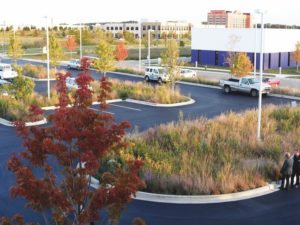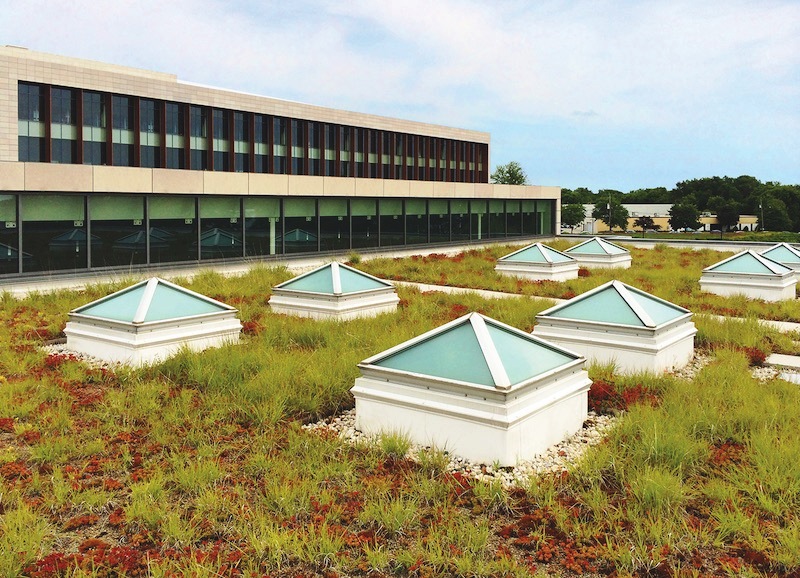When adapting living plants into storm water management systems, the concept of green infrastructure promises many benefits, such as increased infiltration and added habitats for native plants and animals. Maintaining an environment where plants can thrive, however, is challenging. As a result, finding the right plant, for the right set of conditions is critical to success.
 To make this step easier, the Milwaukee Metropolitan Sewerage District (MMSD) partnered with Environmental Consulting & Technology (ECT) to create a plant selection tool for green infrastructure tailored to its region.
To make this step easier, the Milwaukee Metropolitan Sewerage District (MMSD) partnered with Environmental Consulting & Technology (ECT) to create a plant selection tool for green infrastructure tailored to its region.
MMSD sees green infrastructure as an important strategy for meeting its 2035 vision for a healthier region. The goals in this vision include zero basement backups, zero overflows and the capture of the first 1/2 in. of rainfall on impervious surfaces in its service area. This is the equivalent to approximately 740 million gal of storm water.
All types of green infrastructure are supported by MMSD, but strategies that are vegetated and mimic historic hydrology are especially important, including rain gardens, bioretention areas, green roofs and naturalized plantings. Economic benefits of vegetated green infrastructure include added jobs from implementing and maintaining green infrastructure and higher property values around installations.
Social benefits include:
- Reduced health risks associated with the urban heat island effect and air pollution;
- Lower crime rates;
- Safer traffic flow; and
- Community engagement.
Environmental benefits include:
- Improved storm water management;
- Recharged aquifers;
- Erosion control;
- Air quality benefits; and
- Habitats for plants and wildlife.
Like others, MMSD has witnessed a learning curve when it comes to green infrastructure. Several projects have suffered planting failures where invasive weeds have taken over. While some of these failures were from a lack of maintenance, others were the result of poor design decisions. Often the plants chosen were not a good match for the site’s conditions, the owner’s aesthetic expectations or the capabilities of the maintenance crews.
Picking the right plants for green infrastructure requires a thorough understanding of the site’s ecology and long-term stewardship. Green roofs often are constructed of thin, well-drained soils that create environments where sedum plants thrive. Conversely, a rain garden constructed over clay soils without under drainage will create a saturated environment where plants form a wet-prairie community. Plant selection should not be determined by the practice employed. A more comprehensive understanding of the site’s ecology is required.
Ecology
Plants exist within a larger system of hydrology, soil, climatic conditions, associations with other flora and fauna and human maintenance interactions. Plants will only fail through death or competition from other plants when one or more aspects of the site’s ecology are ignored. Some of these factors can be controlled or modified. Others, such as climate and hydrology, are unique to a given place. The good news is that nature has created a plant for nearly every condition and because native plants have already evolved to handle many of the unique conditions of a site, they are often the best place to start.
Stewardship
With green infrastructure, there is no one size fits all solution. It is just as possible to establish a naturalized planting of diverse prairie plants as it is a monoculture of ornamental grasses. The decision to create a manicured garden or a naturalized one should be determined by the owner’s personal desires. When deciding between a naturalized or ornamental planting approach, however, there are a few considerations they should be aware of.
Ornamental Planting Approach
Ornamental landscapes produce simple and bold plant displays. It is a look that communicates control, safety and cleanliness, and it can be easier to keep weeds at bay.
One of the biggest downsides to the ornamental approach is that it has a relatively small number of species used in mass, which may make it vulnerable to pests and diseases, resulting in an unhealthy reliance on pesticides, irrigation and fertilization. It is also a temporary landscape that must be frequently replaced when its component plants die.
Naturalized Planting Approach
Naturalized landscapes offer the promise of continual renewal. Their diversity also makes them naturally more resistant to pests and diseases. The biggest benefit of a natural landscape, however, might be the habitat it creates for native plants and animals.
A downside to a naturalized landscape is that it can appear messy and unkempt to unfamiliar eyes. A sustainable native plant community relies upon its size to be self-propagating. Applying a naturalized planting approach to a small, fragmented space can result in a lot of weed competition. Because many conventional landscapers do not possess the knowledge to discern a native grass or fern from a non-native one, a naturalized landscape can quickly become a weed garden. Many native plant communities also benefit from frequent prescribed burning. For these reasons, if an owner desires a naturalized landscape, it is a good idea to have a maintenance company with restoration ecologists on staff.
Plant Selection Tool
The plant selection tool created by ECT is an interactive excel spreadsheet that users can download from MMSD’s website (www.freshcoastguardians.com/resources/services/plant-selection). Tool users can select the style of planting they desire and then select options from a series of conditions that narrow down a master plant list. The conditions include:
- pH (acidic, neutral, alkaline)
- Soil moisture (dry, mesic, wet, emergent 0 to 6 in., emergent 6 to 12 in.)
- Sun exposure
- Flood duration (short, medium, long)
- Salt exposure (low, medium, high); and
- Planting soil depth (3 to 5 in., 6 to 17 in., 18 to 29 in. and more than 30 in.)
After all of the options are selected, a plant list is produced containing trees, shrubs and herbaceous grasses and perennials that are appropriate for that site’s ecology. If users are not familiar with the site’s conditions, they can select default settings.
The naturalized plant list contains more than 80 plants known to be native to southeast Wisconsin. The ornamental list contains more than 500 plants. A key is offered in the plant list that identifies if a plant is native or not. Users can download written specifications for plant installation and maintenance by selecting a hyperlink within the tool. The installation specifications contain recommendations for plant size, condition and spacing as well as recognized horticultural practices. Tool developers intend for the customized plant lists to be a good starting point in the design process.
Planting Patterns
With the assistance of author and plantsman, Roy Diblik, the ECT team developed standard planting mixes for rain gardens and bioretention areas. The patterns each cover a 9 ft by 12 ft plot but are meant to be modules that can be reduced or expanded to fit the needs of a specific site. There are patterns for both novice and experienced owners.
Photos courtesy of Environmental Consulting & Technology Inc.
This article by Jason Cooper and Andy Kaminski originally appeared in Storm Water Solutions December 2019 issue as “Perfect Plants”. Reprinted here by permission.
Jason Cooper (jacooper@ectinc.com) is principal, landscape architecture for Environmental Consulting & Technology Inc. Andy Kaminski (akaminski@mmsd.com) is a project manager for the Milwaukee Metropolitan Sewerage District.

